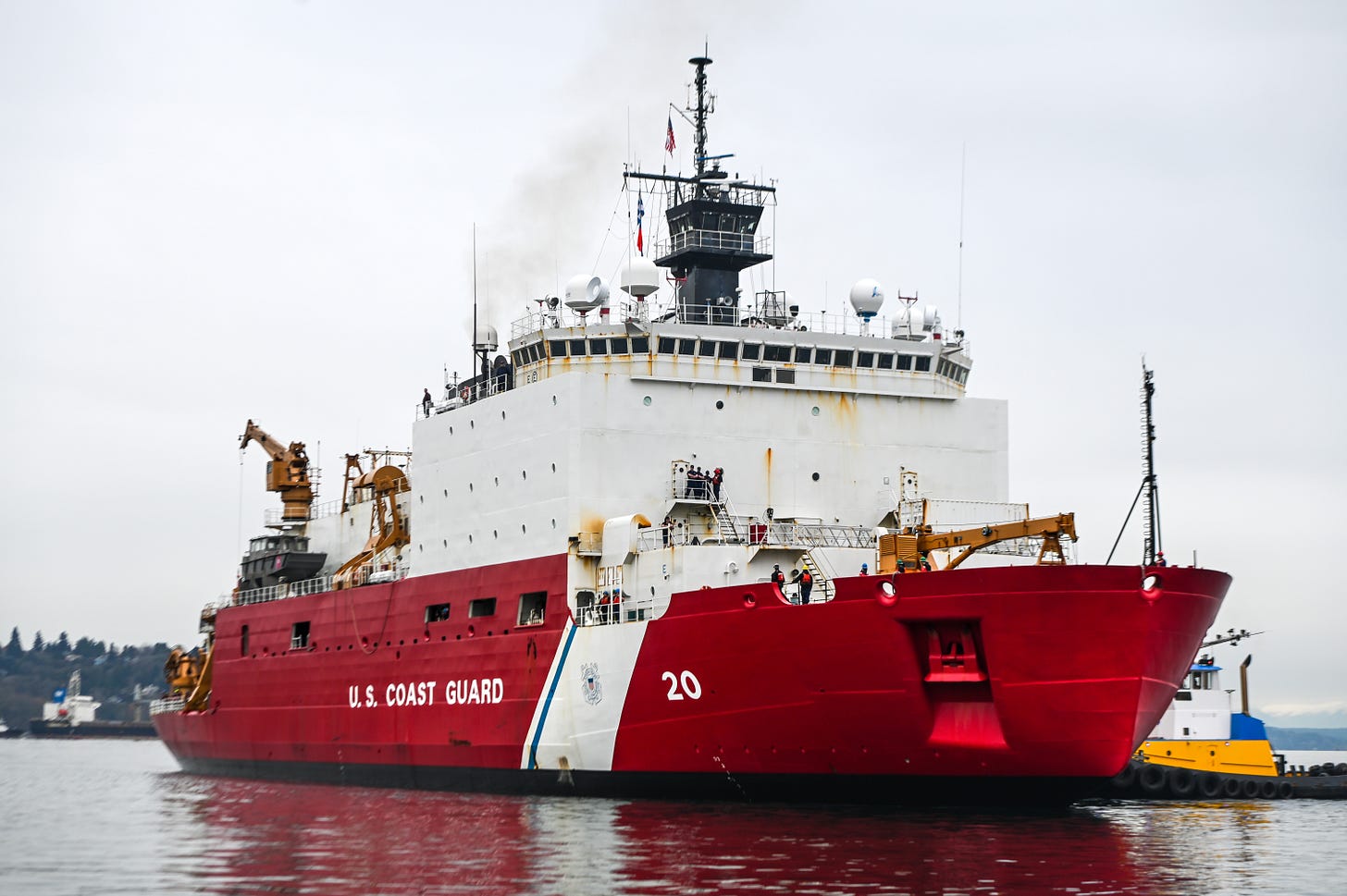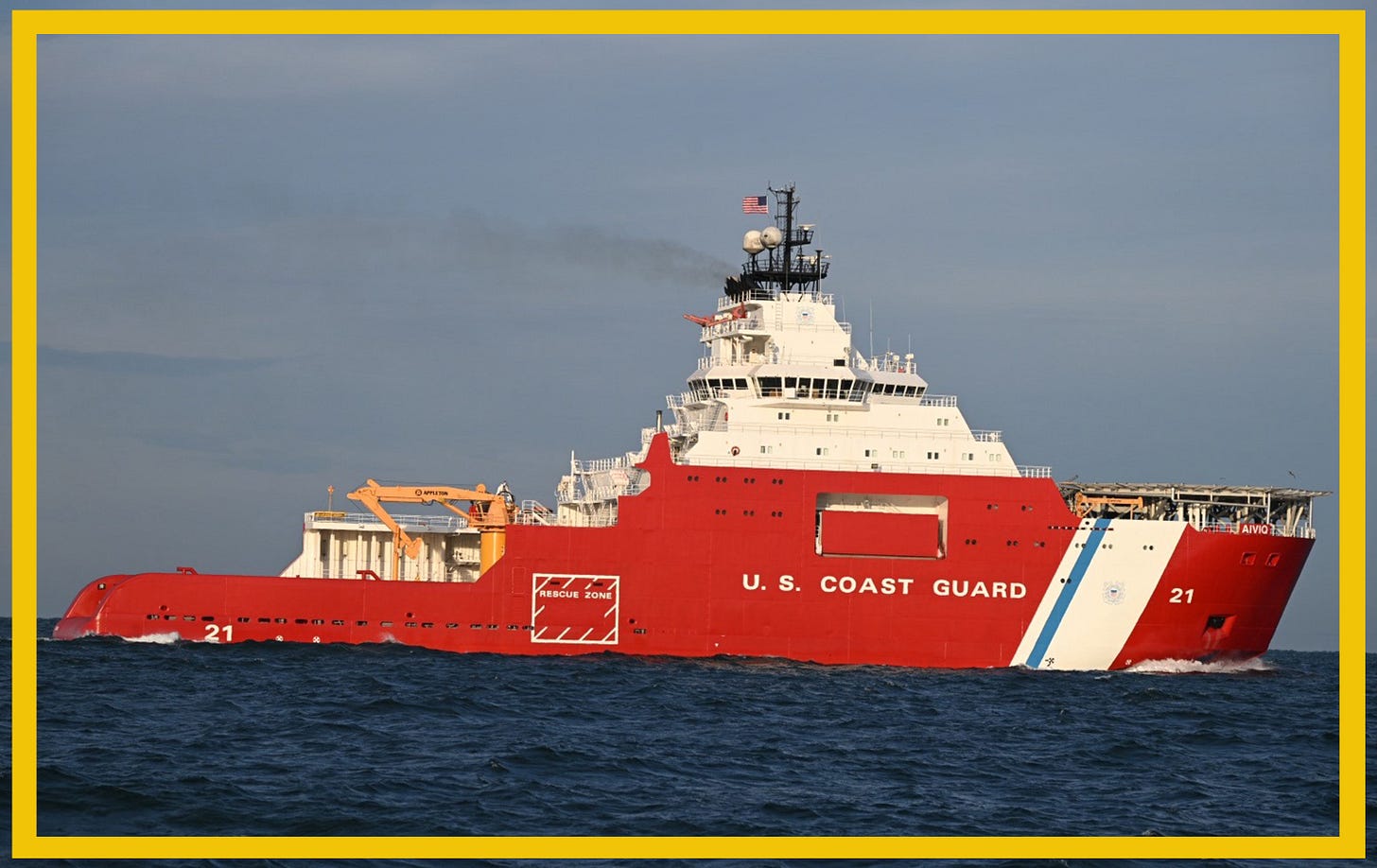U.S. Coast Guard Icebreaking Update
A roundup of recent news related to U.S. Coast Guard polar icebreaking operations
The U.S. Coast Guard only has two operational polar icebreakers, yet its own analysis says that it needs eight or nine to accomplish all of its required missions.
It may surprise some readers to learn that these two icebreakers, the Polar Star and Healy, both spend the vast majority of their time supporting scientific research. During their science focused missions, the icebreakers do support traditional U.S. Coast Guard missions. But the gap in numbers means that non-ice-capable U.S. Coast Guard vessels must also patrol Arctic waters.
Today, we’ll catch up on the recent operations of the U.S. Coast Guard’s polar icebreakers (including acquisition programs) and the other vessels called upon to support Arctic missions.
November 4: U.S. Coast Guard Cutter Stratton (WMSL 752) Completes its Second Arctic Patrol of 2024
In the absence of icebreakers or ice capable vessels, the U.S. Coast Guard regularly deploys National Security Cutters to Arctic waters. This year, Alameda, California based Stratton made two patrols, returning from the second on November 4th. From a U.S. Coast Guard press release:
ALAMEDA, Calif. — The crew of Coast Guard Cutter Stratton (WMSL 752) returned to its Alameda homeport on Nov. 4, after completing a 110-day patrol in the Arctic Ocean, Chukchi Sea and Bering Sea.
Stratton departed Alameda on July 18 and patrolled the Alaskan Inside Passage to Juneau, Alaska, throughout the Gulf of Alaska, the Bering Sea and into the Arctic Ocean. The crew supported U.S. strategic interests in the high latitudes and ensured the safety and compliance of domestic fishery operators. This was Stratton’s second 110-day Alaska patrol in 2024.During the patrol, Stratton’s crew tracked and observed two Russian Federation Navy surface action groups transiting through U.S. waters above the Arctic Circle. Stratton patrolled under Operation Frontier Sentinel, an operation designed to meet presence with presence when strategic competitors operate in and around U.S. waters.
This was Stratton’s second Arctic Patrol this year. The first, from January through April, was limited to the Bering Sea and challenged the capabilities of a ship not designed for Arctic operations. Although the crew did their best, the winter deployment was quite difficult for the ship, as reported by Kenneth Rosen in Foreign Policy.
Hawaii-based National Security Cutter Kimball also made an Arctic deployment in 2024.
In addition to rotational deployments, the only cutter homeported in Alaska- the Alex Haley, based in Kodiak- regularly patrols the Bering Sea and Arctic Ocean. Alex Haley is a former U.S. Navy salvage ship that saw commissioned service between 1971 and 1997 before being acquired and modified by the U.S. Coast Guard in 1999. From the U.S. Coast Guard’s webpage on the Alex Haley:
As the largest Medium Endurance Cutter in the Coast Guard’s fleet, ALEX HALEY boasts a very unique engineering plant and stable design that enables it to ride well in heavy seas like those featured on shows such as “Deadliest Catch.”
November 22: Polar Star Departs Seattle for Operation Deep Freeze
The U.S. Coast Guard’s only ‘heavy’ icebreaker, Polar Star, departed from Seattle on November 22nd for Operation Deep Freeze. From a U.S. Coast Guard press release:
Operation Deep Freeze (ODF) is an annual joint military mission to resupply the United States Antarctic stations in support of the National Science Foundation (NSF), the lead agency for the United States Antarctic Program (USAP). This marks the 28th year that the Polar Star has supported ODF.
Each year, the Polar Star breaks a navigable channel through the ice, allowing fuel and supply ships to reach McMurdo Station, which is the largest Antarctic station and the logistics hub of the USAP.
After a Christmas port visit in Syndey, Australia from 21-27 December, Polar Star is on her way to the Antarctic.
Based on past iterations of Operation Deep Freeze, Polar Star will likely wrap up its mission to McMurdo Station in early February and then proceed to drydock in Vallejo, California (Mare Island) for phase five of a service life extension program (SLEP). She will then briefly return to Seattle before embarking for Operation Deep Freeze 2026. (In 2024, Polar Star returned to Seattle on August 25th following phase four of the SLEP. )
Supporting Operation Deep Freeze will likely continue to be Polar Star’s sole mission.
December 12: Healy Returns from Shortened Arctic Patrol

Back in July, the U.S. Coast Guard’s ‘medium’ icebreaker Healy suffered an on-board electrical fire about six weeks into her summer 2024 Arctic deployment, resulting in an early return to Seattle on August 14th. Following repairs, Healy put to sea on October 1st for a shortened (73 day) patrol.
During this fall Arctic patrol, in addition to conducting the usual U.S. Coast Guard missions in the Chukchi Sea, Bering Sea, and Gulf of Alaska, Healy supported scientific research by the National Oceanographic and Atmospheric Administration (NOAA), the U.S. National Science Foundation (NSF), and the University of New Hampshire. Following completion of these missions she returned to Seattle on December 12th.
Healy is specifically designed to support scientific research in the Arctic and normally deploys annually in support of the National Science Foundation.
It is notable that both of the U.S. Coast Guard’s Polar icebreakers- Polar Star and Healy- were unavailable due to planned and corrective maintenance work during a large portion of China’s summer Arctic mission this summer.
December 19: U.S. Coast Guard Receives Approval to Begin Construction of first Polar Security Cutter
In a widely expected announcement, the U.S. Coast Guard met its commitment to begin construction of the first of its planned three Polar Security Cutters before the end of 2024. This approval allows Bollinger to incorporate eight prototype modules to be used in the vessel itself, meaning that the U.S. Coast Guard can now claim to actually be building one of these long-delayed vessels. (The contract for construction of the first vessel was awarded in April of 2019, more than five years ago. As of this writing, detail design is not complete.)
December 23: Coast Guard Accepts Commercial Icebreaker Aiviq, to be re-named Storis

From a December 23rd U.S. Coast Guard press release:
WASHINGTON — The Coast Guard announced it accepted ownership of the motor vessel Aiviq, a 360-foot polar class 3-equivalent icebreaker, from an Edison Chouest Offshore subsidiary Friday.
The $125 million firm fixed-price contract with Offshore Service Vessels, L.L.C., based in Cut Off, Louisiana, includes delivery, reactivation, technical data, spares, certifications, modifications, crew training and operational readiness activities.
With minimal modifications, the future Storis will be capable of safeguarding U.S. sovereign interests in the Arctic and conducting select Coast Guard missions. The Service will evaluate the vessel’s condition and identify requirements to achieve full operational capability.
The vessel will eventually relocate to its permanent homeport in Juneau, Alaska, following necessary shore infrastructure improvements. Temporary homeport options are currently under evaluation.
It’s about time. Purchasing or leasing an existing commercial icebreaker for the U.S. Coast Guard in order to supplement the fleet is not a new idea, but one that the U.S. Coast Guard has resisted until very recently.
In July 2016, Maritime Executive reported:
In a hearing Tuesday, Representatives Don Young and Duncan Hunter of the House Subcommittee on Coast Guard and Marine Transportation scrutinized the U.S. Coast Guard's opposition to the use of commercial icebreakers. The Coast Guard faces a gap between the retirement of an existing icebreaker and the construction of a replacement; the service has ruled out the use of a vessel not suited to a military mission, and lawmakers questioned whether there was a viable alternative to fill the gap.
Rep. Young pushed Vice Commandant Adm. Charles Michel to explain why he had rejected a proposal for a specific commercial icebreaker, and described Michel’s response regarding a military mission as a "bull---- answer . . . I'm talking about moving ice."
Just a short eight and half years later, the U.S. Coast Guard has taken possession of the vessel. Storis will be operating in the Arctic by 2026- around ten years after that hearing, which was not the first time Congress pushed back against purchasing a commercial icebreaker.
Thoughts and Analysis:
With the exception of the U.S. Coast Guard’s acquisition of Aiviq, this is a fairly standard period of operations for the U.S. Coast Guard’s icebreakers. Polar Star is now on the way to complete its only assigned mission, Operation Deep Freeze. Healy wrapped up its (fire-shortened) annual scientific research mission in the Arctic.
Until the U.S. Coast Guard’s polar icebreaking fleet grows, non-ice capable vessels including National Security Cutters like Stratton and Kimball along with the aging Alex Haley will be required to cover the gap as best they can. But they will not be able to adequately track ice-capable Russian and Chinese vessels during the winter months.
It is in these Arctic patrols where the future Storis will likely find its role, patrolling the waters around Alaska in order to conduct required U.S. Coast Guard missions such as enforcing fishing and safety regulations, conducing search and rescue, protecting the environment, and monitoring the activities of Chinese and Russian vessels when non-ice capable cutters cannot go to sea.
Now is a great time to subscribe, as I have several articles in work. These include an update on European icebreakers, a look at China’s ice-capable vessels, a discussion on why the terms ‘heavy’ and ‘medium’ icebreakers are problematic, and a direct rebuttal to a bit of bad information that refuses to die- the oft heard refrain that ‘Finland can’t build heavy icebreakers.’
I am planning several non-icebreaker articles planned as well. The Finnish Army recently put out a report that includes lessons the Finnish Army is learning from Ukraine, including details that you won’t find in mainstream publications. Finland is also debating withdrawal from the Ottawa convention concerning landmines. And as winter season is upon us, it seems to be an appropriate time to write about living in a land with lots of snow, but no snow days. All of this and more coming soon.
Happy New Year!
All the Best,
PGR



